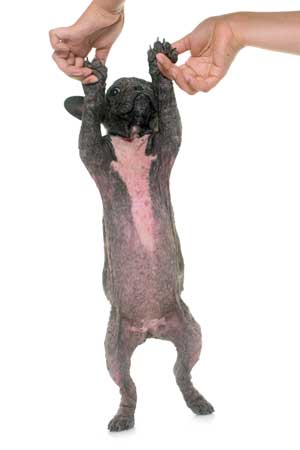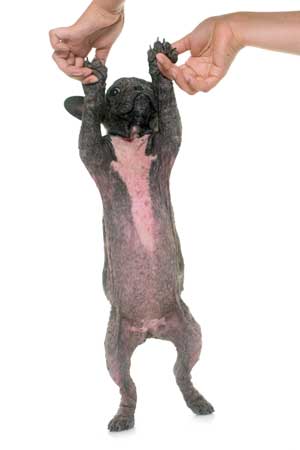
My dog’s stomach is suddenly very bloated and he is very uncomfortable
 Gastric Dilatation and Volvulus (GDV) is a rapidly progressive life-threatening condition in dogs characterised by bloating and twisting of the stomach. Patients admitted with suspected GDV are treated as an emergency as the condition is life threatening. Treatment may require medical and surgical intervention. It is commonly associated with large or giant breed, deep-chested animals between 2 and 10 years of age. Some breeds affected are German Shepherds, Rhodesian Ridgebacks, Great Danes, Dobermans, Irish Setters and Basset hounds but any breed and age can be affected.
Gastric Dilatation and Volvulus (GDV) is a rapidly progressive life-threatening condition in dogs characterised by bloating and twisting of the stomach. Patients admitted with suspected GDV are treated as an emergency as the condition is life threatening. Treatment may require medical and surgical intervention. It is commonly associated with large or giant breed, deep-chested animals between 2 and 10 years of age. Some breeds affected are German Shepherds, Rhodesian Ridgebacks, Great Danes, Dobermans, Irish Setters and Basset hounds but any breed and age can be affected.
Factors that are believed to contribute to the development of GDV include genetics, rapid eating, ingestion of excessive amounts of food or water, delayed emptying of the gastrointestinal system, too much activity after eating and single daily feeding. In some cases, dogs affected by GDV have a history of gastrointestinal tract problems. These characteristics do not necessarily occur with all cases.
It is not known which occurs first, the dilatation (bloating) or the volvulus (rotation). Bloating of the stomach results from the accumulation of gas and food. Rotation of the stomach then does not allow the normal release of these contents, as the outflow passage may also be compromised. Because of the anatomic connection to the stomach, the spleen can also be caught in the twist or be the cause of the condition. This can lead to compromise of this vital organ if not already compromised by tumours or masses.
As pressure within the stomach rises the bloating stomach presses onto the diaphragm and other internal organs causing difficulty with the functioning of the heart and lungs. A number of emergency conditions arise including increased pressure within the abdomen, damage to the cardiovascular system and decreased blood supply to the rest of the gut and body, loss of fluid, and decreased intake of water, leading to dehydration and shock. Organs predominantly affected by the decreased blood supply and oxygen are the heart, stomach wall, the rest of the gut and the spleen.
Dogs will show signs of vomiting foam or trying to vomit with no success, excessive drooling, restlessness and having abdominal pain. An enlarged abdomen or bloated stomach is a tell tale sign but may or may not be present. Some animals can become depressed, lie down or collapse. Further physical examination may also reveal an extremely rapid heartbeat known as tachycardia, laboured breathing referred to as dyspnoea, a weak pulse, and pale mucous membranes (the moist tissues lining the nose and mouth).
The veterinarian will make a diagnosis by referring to the history of the patient, predisposing factors and clinical signs seen when entering the veterinary practice. Radiographs of the abdomen are almost always needed to confirm the diagnosis of GDV although in some cases the breed, history and clinical signs are so clear cut that the vet will make the diagnosis without having to do X-rays. Further blood tests may be needed to determine how compromised the patient is.
Aggressive treatment is required to ensure the animal’s survival. The primary goals of treatment are to make sure the volume of blood through the animal’s body is restored by administering fluids through an intravenous catheter (a catheter that is inserted into a vein for supplying medications or nutrients) and to decompress the stomach by passing a tube into the stomach through the mouth to release gas and draw out excess fluid. These processes are usually done under sedation. Once relatively stabilised, the patient is prepared for surgery to correct the torsion of the organs. In some cases the vet may decide to do the surgery almost immediately and in other cases the vet may suggest a period of stabilisation, before the surgery is done. The aim of treatment is to return the spleen and stomach to their normal position within the body. It may be necessary to remove the spleen if it is suspected to be the cause of the condition or if its blood supply is compromised during the ordeal. The surgical procedure to prevent the stomach from twisting again is called a gastropexy. During this operation the stomach wall is attached to the body wall by the surgeon allowing for the permanent normal positioning and decreasing the chance of reoccurrence of the condition. Your pet will be given antibiotics, painkillers, and anti-nausea medication and the fluid therapy will be continued after the surgery. Sometimes, if the blood supply of the stomach is cut off to such an extent that certain parts of the stomach wall receives no blood, the stomach wall will begin to die off leading a major crisis where part of the stomach wall has to be removed during surgery. Other times, the bloated stomach can press onto the heart muscle to such an extent that the blood supply of the muscle wall of the heart is cut off leading to major heart damage. These complications can happen in a matter of hours and this is why this condition is always considered an emergency and why it is so critically important that no time is wasted to get such an animal to the vet. “Leaving the animal to the morning” to see if they will be better, is never an option with this condition as the damage done in a brief number of hours is significant enough to cause death. In some cases the stomach may burst, which almost inevitably leave to death, even if the dog was still presented live at the vet.
It is best to hospitalise these patients for a few days after the surgery and to monitor their progress closely. Irregular heartbeats or compromised functioning of the heart, infection called sepsis and inflammation or infection of the abdominal wall called peritonitis may be some of the complications encountered. Even if the surgery was successful the animal may still die of these complications a few days after surgery. Post-operative care is paramount to the successful treatment of this condition.
Animals must be allowed time to heal at home once discharged. Remember to administer any tablets given by the vet and allow your pet to rest even if they are looking and feeling much better. While the exact causes of GDV are unknown, there are a number of risk factors that can be addressed including avoiding stress, feeding multiple smaller meals rather than large single daily meals and avoiding exercise or playing immediately after eating and drinking.
It has been shown that animals treated within the first 6 hours after the onset of the condition have the best chance of survival. Even so, the mortality rate is 25 to 30% with an incremental increase after this time. This is an emergency condition and needs to be treated by a veterinarian as soon as possible. If you suspect your dog of suffering with this condition never ever wait to see if it will improve by itself. Always get it to the vet as quickly as you can and if it happens after hours and the vet is closed, take it to the nearest emergency veterinary clinic.
© 2018 Vetwebsites – The Code Company Trading (Pty) Ltd
